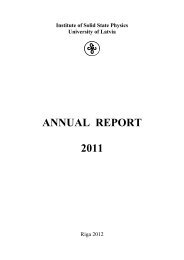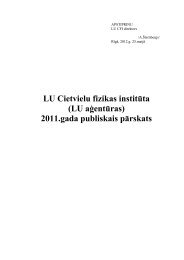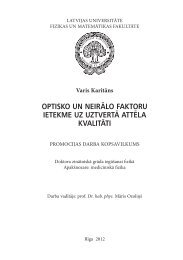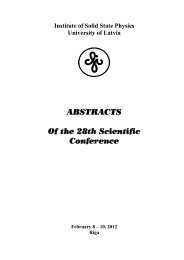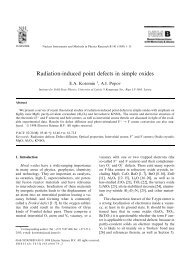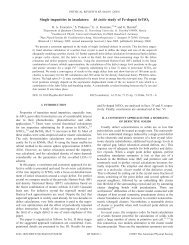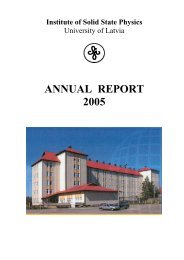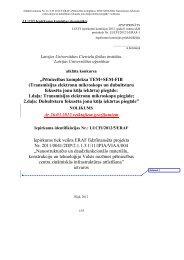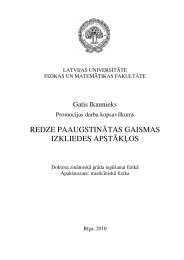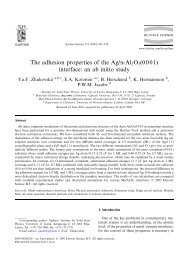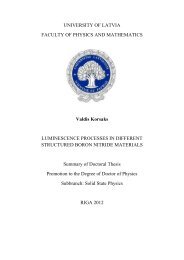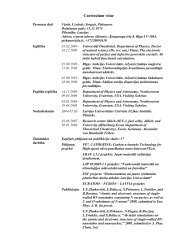Annual Report 2012 - Latvijas Universitātes Cietvielu fizikas institūts
Annual Report 2012 - Latvijas Universitātes Cietvielu fizikas institūts
Annual Report 2012 - Latvijas Universitātes Cietvielu fizikas institūts
Create successful ePaper yourself
Turn your PDF publications into a flip-book with our unique Google optimized e-Paper software.
ands. Because of the surface effect, the O bands move downward, toward the VBs with<br />
respect to the relevant bands in the bulk case, and this leads to narrowing of the VB →<br />
O gap and widening of the O → H gap which corresponds to the first optical absorption.<br />
We calculated also the surface relaxation and energetics for the polar (111)<br />
surface of SrZrO 3 with both Zr- and SrO 3 -terminations. In both cases upper layer atoms<br />
are relaxed inwards. The second layer atoms, with the sole exception of Zr-terminated<br />
SrZrO 3 (111) surface Sr atom, relax outwards. The calculated surface relaxation energy<br />
for Zr-terminated SrZrO 3 (111) surface is almost 16x larger, than the surface relaxation<br />
energy for SrO 3 -terminated SrZrO 3 (111) surface. The surface energy for Zr-terminated<br />
SrZrO 3 (111) surface is smaller, than that for for SrO 3 -terminated one.<br />
ELECTRONIC CHARGE REDISTRIBUTION IN LaAlO 3 (001) THIN<br />
DEPOSITED AT SrTiO 3 (001) SUBSTRATE: FIRST-PRINCIPLES ANALYSIS<br />
AND A ROLE OF STOICHIOMETRY<br />
A. Sorokine, D. Bocharov, S. Piskunov, and V. Kashcheyevs<br />
The discovery of conducting interface between two insulating materials: TiO 2 -<br />
terminated (001) surface of SrTiO 3 (STO) substrate and LaAlO 3 (LAO) film deposited<br />
atop of it, has attracted colossal scientific interest during the last few years. Recently,<br />
high application potential of LAO/STO heterointerfaces has been proven e.g. by<br />
fabrication of highly voltage-tunable oxide diode that utilizes the advantage of the<br />
electric-field controlled interfacial metal-insulator transition of LAO/STO. Despite<br />
intense research efforts the origin of the charge carriers and the structure of the<br />
LAO/STO conducting layer are still controversially discussed. Currently, the whole<br />
picture responsible for adequate interpretation of experimental observations going in line<br />
with theoretical predictions is not yet clear. One of particular reasons for that is the fact<br />
that the major number of first principles studies carried out to describe structural and<br />
electronic properties of LAO/STO interfaces assume that the LAO films are perfectly<br />
stoichiometric. However, both pulsed laser deposition and molecular beam epitaxy<br />
vaporization processes used to facilitate transfer through the vapor LAO phase cannot<br />
preserve the target stoichiometry during LAO/STO synthesis. Taking into account that<br />
in fact La/Al ratio of nonstoichiometric LAO films may be controlled during its epitaxial<br />
growth, in our study we eliminate the above mentioned drawback by considering from<br />
first principles both n-LAO/STO and p-LAO/STO heterointerfaces having La or Al<br />
nonstoihiometry.<br />
58



